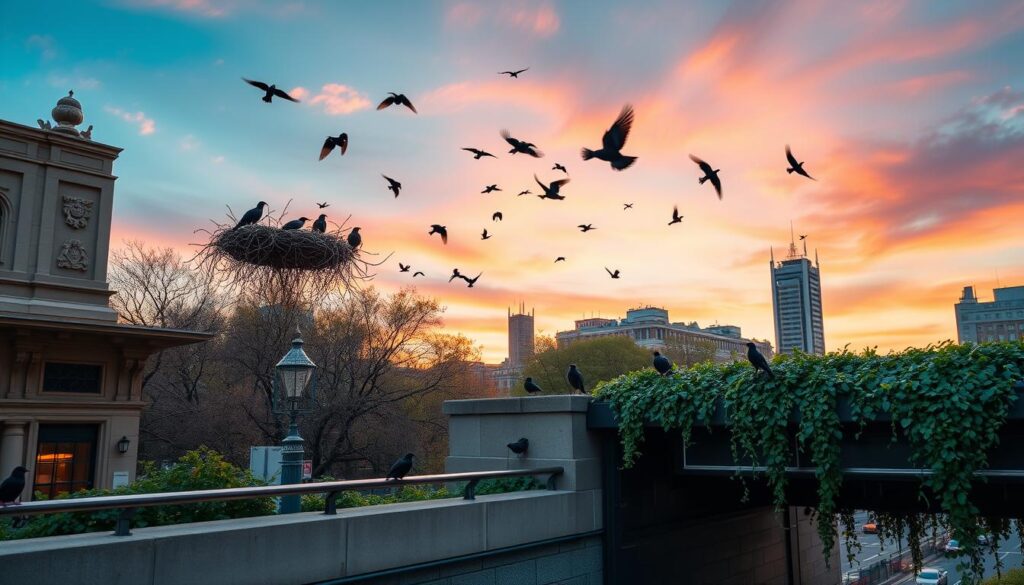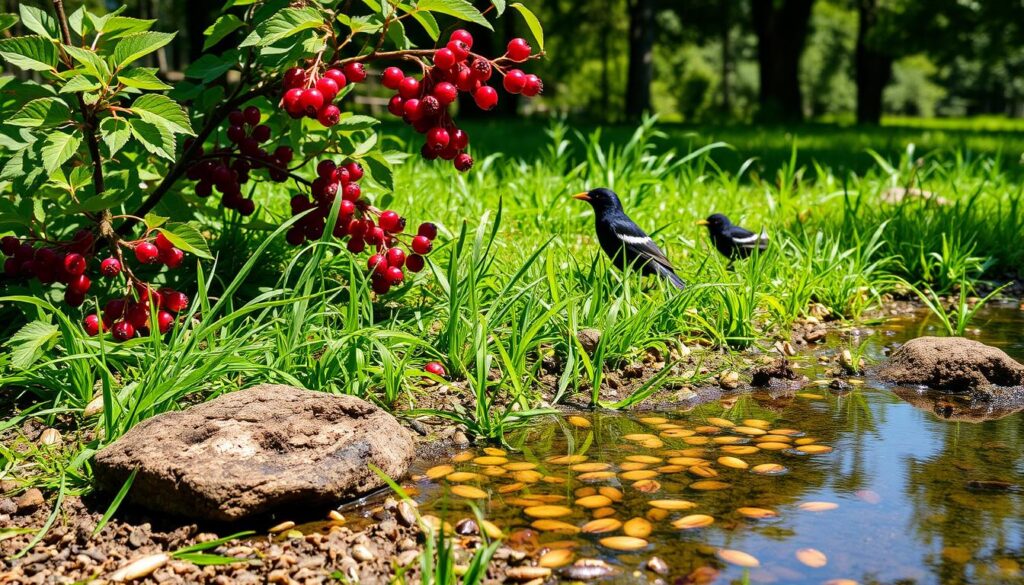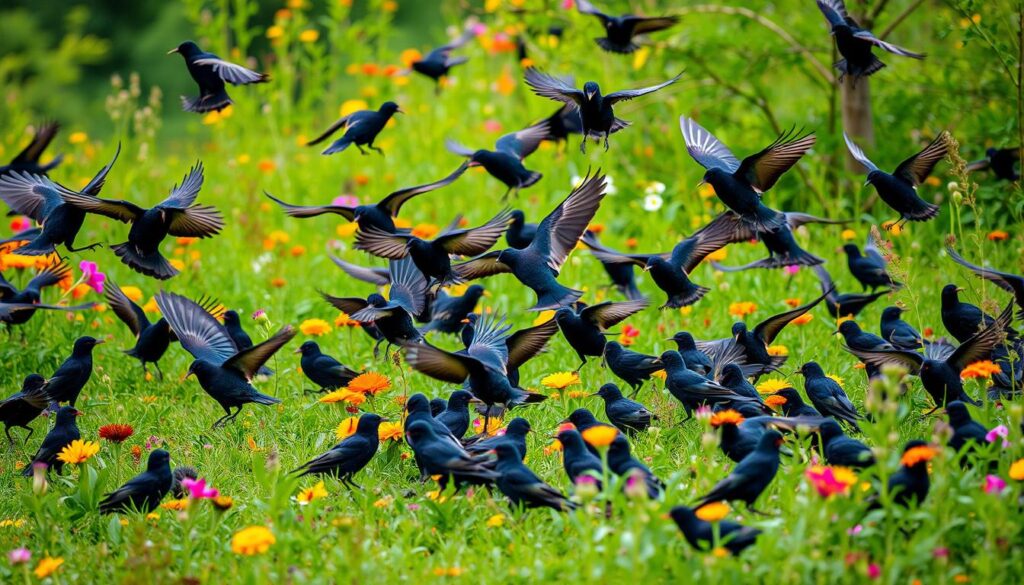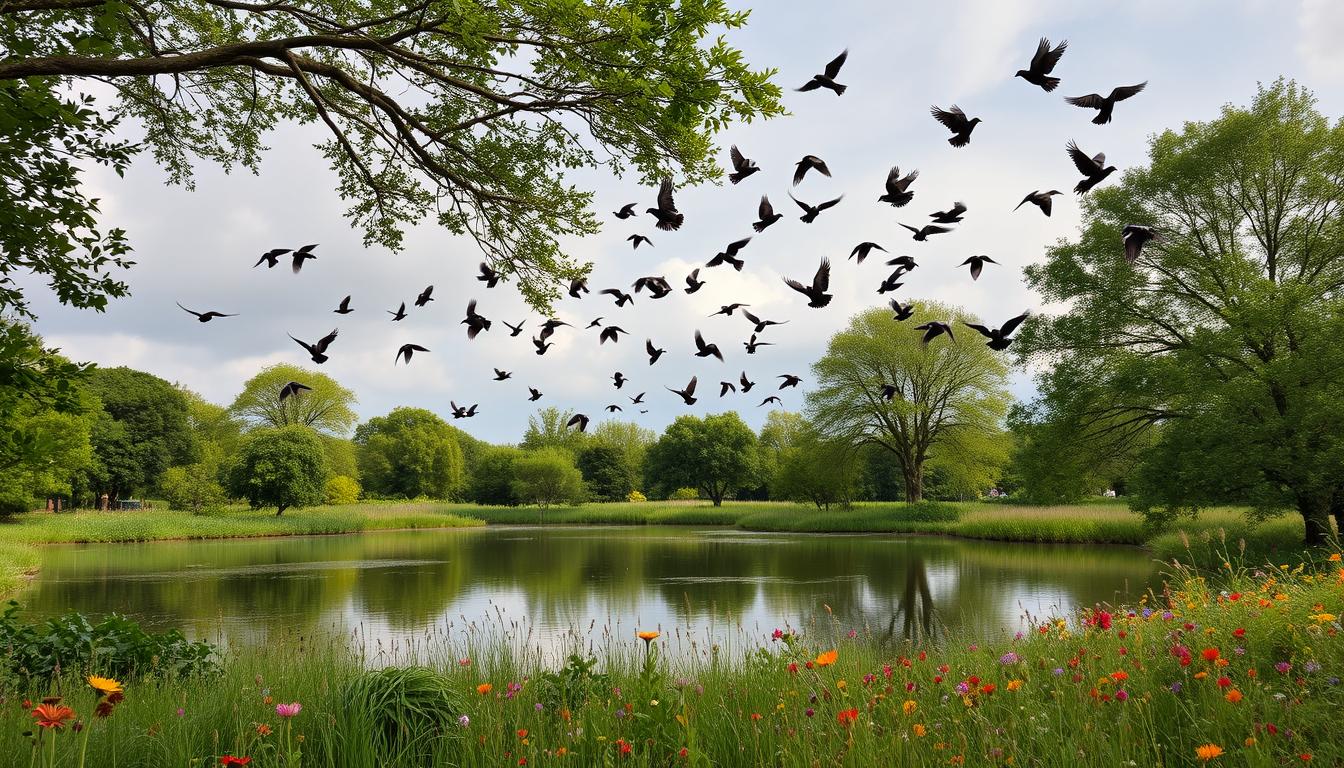To create a Starling habitat, you need to know what these birds like. They need the right places to nest. A good habitat lets them live well.
Knowing what Starlings need is key to making a welcoming space. By setting up the right conditions, you can draw them to your yard. Their habitat is more than just a place to live; it’s a whole world.
Key Takeaways
- Understanding the unique needs of Starlings is crucial for creating a suitable habitat.
- Ideal nesting sites are essential for the survival of Starlings.
- A well-designed Starling habitat provides a suitable environment for the birds to thrive.
- Providing the right conditions is essential for attracting Starlings to your backyard.
- Creating a Starling-friendly environment requires careful consideration of various factors.
- The Starling habitat is a complex ecosystem that requires attention to detail.
- By creating a Starling habitat, you can support the well-being of these birds.
Understanding the Natural Starling Habitat
Starlings live in many places like forests, grasslands, and wetlands. Their homes change with the seasons. They move to find food and places to nest. Knowing where they live helps us understand their needs.
Starlings have different ways of nesting. Some like tree holes, while others prefer rock crevices or old burrows. Knowing this helps us protect them and create better homes for them.
- Food availability: They need insects, seeds, and fruits to eat.
- Water sources: They need water for drinking, bathing, and hunting.
- Nesting sites: They look for places like tree cavities, rock crevices, or old burrows to nest.
Learning about starlings’ homes and how they nest helps us see why we must protect their habitats. It also shows us how to make artificial homes that meet their needs.
Essential Features of Starling Territory
To make a Starling-friendly habitat, you need to think about a few key things. You’ll want to have different types of plants, like trees, shrubs, and ground cover. These plants give the birds food, shelter, and places to nest.
It’s also important to have water around, like ponds or birdbaths. Birds need water for drinking and to bathe in.
Starlings like to nest in places like tree cavities or under eaves. You can help them by setting up nest boxes. It’s also good to have a variety of food, like insects, seeds, and fruits. You can do this by planting native plants or putting out food.
Here’s a quick list of what Starlings need in their territory:
- Vegetation diversity, including trees, shrubs, and ground cover
- Water sources, such as ponds or birdbaths
- Nesting sites, including natural and artificial options
- Food sources, such as insects, seeds, and fruits
By adding these features to your backyard or garden, you can make a welcoming place for Starlings. These features are vital for the health and happiness of Starlings. By providing them, you help in the conservation of these wonderful birds.
Preferred Nesting Locations in the Wild
Starlings are adaptable and can live in many places. Their choice of where to nest is key to their survival. In cities, they often pick spots that are safe and easy to get to. The Humane Society says they can be found in backyards and gardens.
In the wild, Starlings like to nest in tree holes, rock cracks, and other hidden spots. These places protect them from predators and bad weather. Some of the best spots for nesting include:
- Tree cavities with small entrances
- Rock crevices with enough room for nesting
- Natural shelters like hollow logs or brush piles

Knowing what Starlings prefer for nesting helps us make better homes for them in cities. This way, we can live better together with these birds.
Urban Adaptation and Modern Starling Habitat
Starlings have shown amazing urban adaptation skills, thriving in cities and towns across the United States. Creating a modern Starling habitat in urban areas is now key. This can be done by setting up nest boxes or bird-friendly gardens.
Some key features of a modern Starling habitat include:
- Food sources, such as insects and fruits
- Water sources, like birdbaths or ponds
- Nesting sites, including trees or buildings with suitable cavities
By adding these features, we can make urban areas welcoming for Starlings. This helps the birds and makes cities more beautiful and green.
To create a modern Starling habitat, we must think about what the birds need. This way, we can live better with Starlings in cities, making our environment richer and more diverse.
Creating the Ideal Nesting Environment
To welcome Starlings, you need the right nesting materials and to support conservation. Twigs, grasses, and plant fibers are great for building a strong nest.
When setting up a nest box, think about the Starling’s size and preferences. Important features include:
- A entrance hole that is approximately 2.5 inches in diameter
- A depth of around 6-8 inches to provide ample space for nesting
- A roof or overhang to protect the nest from the elements
Nest Box Placement and Safety Features
Choose a safe spot for the nest box, away from predators. Trees or fence posts are good options. Adding a predator guard or roof extension can also help keep the nest safe.
With the right materials and conservation support, you can create a great home for Starlings. This helps them thrive and stay healthy.
Food Sources in a Starling Habitat
Starlings are omnivores, eating insects, seeds, and fruits. They search for food on the ground, in trees, and in the air. Finding diverse food sources is key for their survival, and losing habitats can hurt their ability to eat.
Starlings eat insects like grasshoppers and crickets, and seeds from trees and grasses. They also enjoy fruits, like berries and cherries. Bird feeders and bird baths can also offer them food.
Natural Diet Components
- Insects, such as grasshoppers and crickets
- Seeds from trees and grasses
- Fruits, including berries and cherries
Supplementary Feeding Options
Supplementary feeding can help Starlings, especially where food is scarce. Options include:
- Bird feeders, such as suet feeders and seed feeders
- Bird baths, which provide water for drinking and bathing

Offering a variety of food sources helps Starlings stay healthy. This is crucial in areas where natural food is hard to find. It makes it easier for them to survive.
Water Requirements and Features
Creating a Starling habitat means having a reliable water source. Water features are key to attracting these birds. Starlings drink, bathe, and forage in water, making it essential.
There are many water feature options. Some popular ones include:
- Birdbaths with fresh, clean water
- Ponds or small pools with shallow areas for bathing
- Dripping or misting systems to create a humid microclimate
- Shallow dishes or trays filled with water and pebbles for perching and drinking
Make sure the water features are safe and easy for Starlings to access. Place them in spots that protect from predators. Also, ensure water is available all year.
It’s also crucial to keep the water clean and accessible. The water should be free from contaminants. Make sure it’s easy for the birds to see and reach.
| Water Feature | Description | Benefits |
|---|---|---|
| Birdbath | A shallow dish filled with fresh water | Provides drinking and bathing water for Starlings |
| Pond | A small pool of water with shallow areas | Offers a source of water for drinking, bathing, and foraging |
| Dripping system | A system that creates a humid microclimate | Provides a source of water and creates a humid environment |
By adding these water features to your habitat, you’ll make it welcoming for Starlings.
Vegetation and Plant Life for Starling Environments
Creating a Starling-friendly environment means thinking about the right plants. Plants are key for food, shelter, and breeding spots for these birds. A mix of plants will draw in insects, seeds, and fruits for Starlings to eat.
Good trees and shrubs for Starlings include native oak trees, willows, and elderberries. They offer berries, insects, and seeds. Ground covers like clover and creeping thyme also help, attracting insects and giving Starlings a safe spot to search for food.
- Plant a variety of native trees and shrubs that provide food and shelter for Starlings
- Incorporate ground cover options that attract insects and provide a safe place for foraging
- Avoid using pesticides, which can harm Starlings and other wildlife
By offering a variety of plants, you make your backyard a welcoming place for Starlings and other wildlife. Choose plants native to your area and right for your climate. With some planning and creativity, your backyard can become a lively Starling habitat.
| Plant Type | Benefits for Starlings |
|---|---|
| Native Oak Trees | Provide acorns and insects for food |
| Willows | Offer shelter and insects for food |
| Elderberries | Provide berries and insects for food |
Social Behavior and Community Needs
Starlings are known for their complex social behavior. They often form large flocks. These flocks need specific community needs to thrive. To create a good environment for them, it’s key to understand their behavior and how they communicate.
By making your backyard or garden a welcoming place, you can attract Starlings. This supports their social behavior and community needs.
Here are some ways to make your space more welcoming:
- Provide multiple food sources, like bird feeders and berry bushes.
- Create a water feature, such as a birdbath or pond, for drinking and bathing.
- Offer nesting sites, like tree cavities or nest boxes, for breeding and raising young.
For more tips on welcoming small pets, including birds, check out this resource.
By understanding and supporting the social behavior and community needs of Starlings, you can make your backyard or garden a thriving place for them.

Seasonal Maintenance of Starling Habitat
As the seasons change, it’s key to keep the Starling habitat ready. This means getting the habitat ready for each season. It also means changing it to fit the Starlings’ needs. To learn more about Starlings and their homes, check out the European Starling page on Animal Diversity Web.
Some important tasks for seasonal maintenance of Starling habitat include:
- Cleaning and repairing nesting boxes
- Providing supplemental food sources
- Ensuring access to fresh water
In the spring, getting the habitat ready for breeding is crucial. This means cleaning and fixing nesting boxes, and offering extra food. In the winter, the focus is on
Winter Adaptations
like making sure there’s fresh water and shelter from the cold. By doing these tasks, you help create a great place for Starlings to live all year.
Common Threats to Starling Habitats
Starling habitats face many dangers, like habitat loss from urban growth and deforestation. This loss harms natural places, making it hard for Starlings to find places to breed and nest.
Other dangers include predation by birds of prey, like hawks and owls. Also, climate change changes where food and nesting sites are. Starlings are also at risk from diseases and parasites, which can hurt their numbers a lot.
Here are some ways to fight these dangers:
- Building artificial nesting sites, like nest boxes, for breeding places
- Starting conservation efforts, like restoring habitats, to keep natural places safe
- Using fewer pesticides and chemicals that harm Starlings and their homes
Knowing the dangers to Starling habitats helps us protect these birds and their homes. This way, we can help Starlings survive for a long time.
Conservation Strategies for Protecting Starling Environments
Protecting Starling environments is key to their survival. We can do this by using effective conservation strategies. These strategies help keep Starling habitats safe and healthy for the future.
Some important strategies include habitat restoration and wildlife-friendly practices. We can use these in many ways, like:
- Creating artificial nesting sites, such as nest boxes, to provide Starlings with a safe place to breed and raise their young
- Planting native vegetation, such as trees and shrubs, to provide food and shelter for Starlings
- Implementing sustainable land-use practices, such as reducing pesticide use and preserving natural habitats, to minimize the impact of human activities on Starling populations
Getting the community involved is also crucial. By working together, we can spread the word about Starling conservation.
Habitat Preservation Techniques
Habitat preservation is a vital part of protecting Starlings. It involves keeping natural habitats like forests, grasslands, and wetlands safe. This gives Starlings the food, shelter, and places to breed they need to thrive.
Community Involvement Options
Community involvement is also key. By getting people involved, we can work together to protect Starling habitats. This can include activities like bird-watching tours, conservation workshops, and community-based monitoring programs.
Legal Considerations When Creating Habitats
Creating habitats for starlings requires careful attention to legal matters. Legal considerations when creating habitats involve getting the right permits and following local laws. These steps are crucial to ensure the habitat is built legally and responsibly.
Some important things to think about include:
- Getting the necessary permits and licenses
- Following local zoning laws and regulations
- Making sure the habitat doesn’t harm the environment or other species
- Respecting private property rights and getting the right permissions
Before starting, it’s vital to know the laws and regulations in your area. You can talk to local wildlife experts, government agencies, or environmental groups. By following these legal steps, you can make your starling habitat a success.
| Regulation | Description |
|---|---|
| Endangered Species Act | Regulates the protection of endangered species and their habitats |
| Wildlife Conservation Law | Regulates the conservation of wildlife and their habitats |
| Environmental Protection Act | Regulates the protection of the environment and natural resources |
Taking Action: Transform Your Backyard into a Starling Haven
Do you want to make your backyard a welcoming spot for Starlings? It’s time to take action and turn your outdoor area into a Starling paradise. With the right features and resources, you can draw these fascinating birds to your yard. Then, you can watch their lively antics up close.
Begin by setting up high-quality nesting boxes in key spots around your yard. Make sure the boxes fit the Starlings’ size and placement needs. Also, plant native trees, shrubs, and ground cover. These will give the Starlings plenty of food and shelter.
Offer a variety of foods like mealworms, suet cakes, and fresh fruits to enrich their diet. Make sure they have a reliable water source, like a birdbath or shallow dish. These simple steps will help you create a vibrant Starling habitat in your backyard.
By making your outdoor space a Starling haven, you’ll not only attract these birds but also help their conservation. Enjoy watching Starlings up close and join others who care about these amazing creatures.
FAQ
What is the natural habitat of Starlings?
Starlings come from Europe and Asia. They live in many places like woodlands, grasslands, and cities. They like areas with lots of plants and places to find food and nest.
Where do Starlings build their nests?
They nest in tree holes, boxes, and safe spots like building corners. They choose places that keep them safe from harm.
What do Starlings eat in their natural habitat?
They eat insects, berries, seeds, and small animals. They can find food in both wild and city areas.
How do Starlings adapt to urban environments?
They easily adapt to city life. They use buildings and bridges for homes and find food in cities.
What are the essential features of a Starling-friendly habitat?
A good habitat has nesting spots, food, and water. Adding plants like trees and shrubs helps attract them.
How can I protect Starling habitats from threats?
We must protect their homes from loss, predators, and climate change. We can do this by saving natural areas and providing food and water. Working with local groups helps too.
What are the legal considerations when creating a Starling habitat?
Know the laws about creating habitats for Starlings. This includes getting permits and following local rules. Always check the laws before starting.
How can I transform my backyard into a Starling haven?
Make your backyard welcoming by adding nesting spots, food, and water. Install nest boxes and bird baths. Plant native plants for shelter and food. This will attract Starlings and help them thrive.

